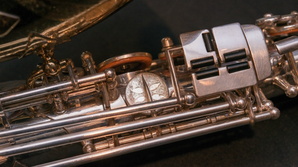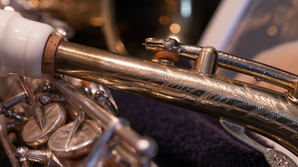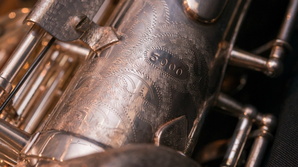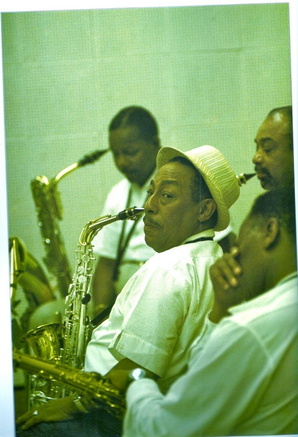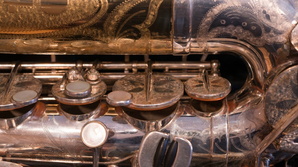eBay Ad Copy:
For sale ($50,000)
One of Johnny Hodges's alto saxophones, owned and played by the jazz giant from The Duke Ellington Jazz Orchestra.
It is currently owned and played by another jazz great Frank Wess who acquired it from Johnny Hodges's estate.
The horn has been lovingly cared for, professionally maintained and kept in perfect playable condition by Tomoji Hirakata in NYC.
Frank played this horn while he was with The Toshiko Akiyoshi Big Band as well as many other gigs.
There simply just are not many pictures of Johnny Hodges playing this horn. This horn came along later in Johnny Hodges's career in the early 60s.
I finally found one photo of Johnny Hodges playing the horn which I have posted here.
The photo is from a book called "Jazz Giants" A Visual Retrospective compiled by K.Abe.
The photo was taken by Arthur Singer.
I'm sure you will recognize the other people in the photo (even I know who they are!)
I believe it's from "The Far East Sweet" recorded at RCA Victors Studio NYC 1966.
Frank remembers Johnny playing the horn on a few record dates they did together as do a few other jazz musicians I have spoken to.
Over the years Johnny Hodges played a few different horns possibly including another one with a snakes head on top of the octave key, but only one that has a silver body with a brass bell.
The horn was made and engraved by Beaugnier (France) and then, maybe assembled in the US.
The key system you can call “Leblanc Rationale” System or Semi-Rationale.
I have received quite a few emails from people telling me that the horn is a Leblanc, NOT a Rationale.
All I can say is that the techs who have actually held the horn in their hands have the following to say:
This Johnny Hodges horn is a Leblanc Rationale with the Vito name on it. A Vito/Leblanc Model 35 Alto Saxophone Rationale/Semi-Rationnel. The Vito model had all adjustments by cork; the Leblanc had the fancy set screws and small nuts throughout for registration. The Rationale system was described as "The Boehm system for sax". The design was by Hovenhaghel in the 1930's but never caught on. It allows many alternate fingerings. Do doubt something Johnny Hodges was keen to make good use of. It would seem likely that the silver body, pearl inlays on the left palm keys, the engraving, the white left thumb rest, the diamonds in the eyes, and "Johnny Hodges" engraved inside the bell would all indicate that this horn was customized or made special for Mr Hodges.
Here is some more information from the web:
The Model 35 has LeBlanc Rationale-style keywork. Don't worry though, all the notes are fingered the same as regular saxes, it just allows for additional alternative fingerings if you choose to learn and use them.
-The major difference is that the High F# key is up by the lefthand palm keys.
-The G key consists of two pads, as found on some King horns and elsewhere. This is for better intonation.
-As a consequence the G# key opening is on the 'back' of the horn, nearest the player, instead of compromising its position to fit in amongst the stack keys.
-The horn does have the 'Forked Eb' in the lower stack....allowing that alternative finger if desired.
-The horn has an articulated low C# which is closed by the low B, just like the Selmer horns and their various clones
-And of course it has the alternative Rationale fingerings if you choose to learn and use them.
This Model 35 is arguably the rarest and greatest of them all. LeBlanc created an alternate fingering system; one which allows the player to finger the keys conventionally but also includes a number of alternate fingerings and mechanical improvements. Essentially, LeBlanc/Beaugnier produced 2 variations of this system: the "Rationale" version, and the "System" version (sometimes called the "Semi-Rationale"). It would turn into a Novella to describe them both in detail here.
All Vito 35's 'are' Leblanc 'modified' versions of the Rationale horns... They 'do' feel clunky to me too, they are a monster of purpose... 35's have a F#3 key... The beautiful Hodges' horn appears to have silver/gold/engravings uncommon to the 'limited' production models of the 35's
models 35,36,37,38,39 & 40 was the Jimmy Hodges model, a silver engraved fancy model 35.
The body is silver plating over the brass.
I found one tone hole that does not have coating on and it has green stuff. (it’s clean now). This green stuff is a byproduct of prolonged human contact on untreated brass. As you can see in the photos it has been cleaned and restored.
Brass can be : Yellow brass 70% copper, 30% zinc
Red Brass 85% copper, 15% zinc.
And Nickel Silver 67% copper, 18% nickel, 15% zinc.
That's my story and I'm sticking to it !
All debates aside, the fact remains that this sax does belong to Frank Wess. Mr.Wess did indeed buy it from Johnny Hodges's estate and had seen Johnny play the sax with his own eyes. I don't how well you know Frank, but if any of you want to challenge him on these facts, be my guest !
Please view the photos and you will see this horn has been meticulously maintained and is not just a flawless musical instrument but it is also a work of art.
You can also view a YouTube video (filmed by Tomoji) where you can hear Frank Wess speak a little about the horn while you see how well it has been cared for. (Yes, there really are diamonds in the eyes of the snake)
Sorry, Ebay does not allow links to be posted in auctions.
Ebay only allows for 12 pictures but I have many more which I will email to you upon request.
The white mouthpiece with Johnny Hodges's name etched on the side is included in this sale, as is the case. It is the original Leblanc case. All are sold "as is."
Who am "I" ??
I am Michelle Dodgion. The youngest daughter of saxophonist Jerry Dodgion. I got my start as an Ebay trading assistant helping out my dad by selling some of his saxophones,
mouthpieces, etc on Ebay. One thing led to another and now I do this for many of my dads friends.
Frank Wess is one of our most favorite people on earth! I took flute lessons from him in High School.
Johnny Hodges was one of my dad's and Frank's greatest influences.
It is my great honor and pleasure to assist Frank with this sale.
This saxophone represents a legacy, a love, and a respect for some of the greatest music ever played in human history.
It is my wish that the person who purchases this legendary instrument continues this tradition.<
Page generated in 0.023 s (21 SQL queries in 0.015 s) -
Powered by Piwigo


